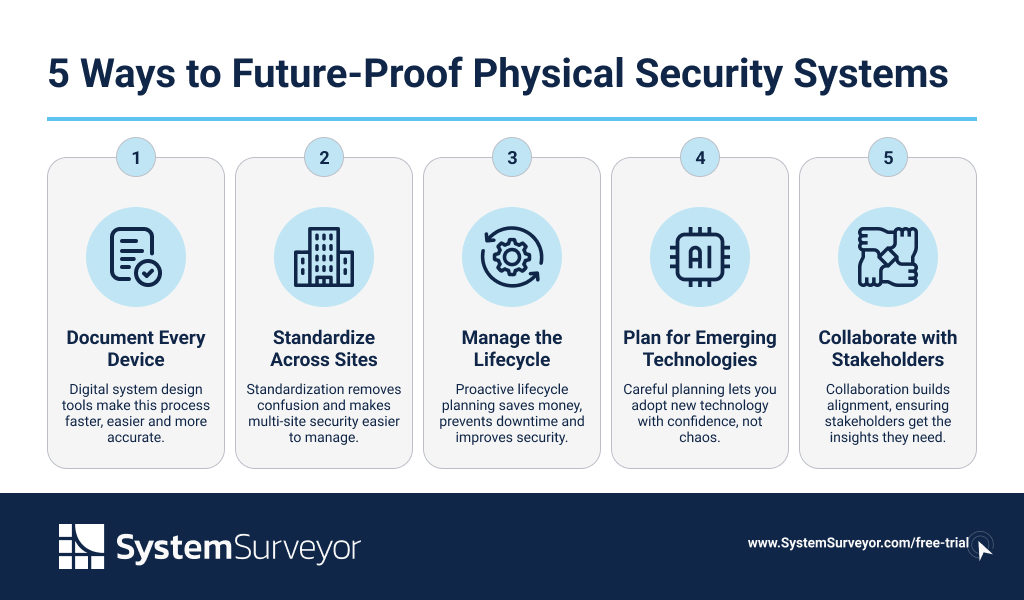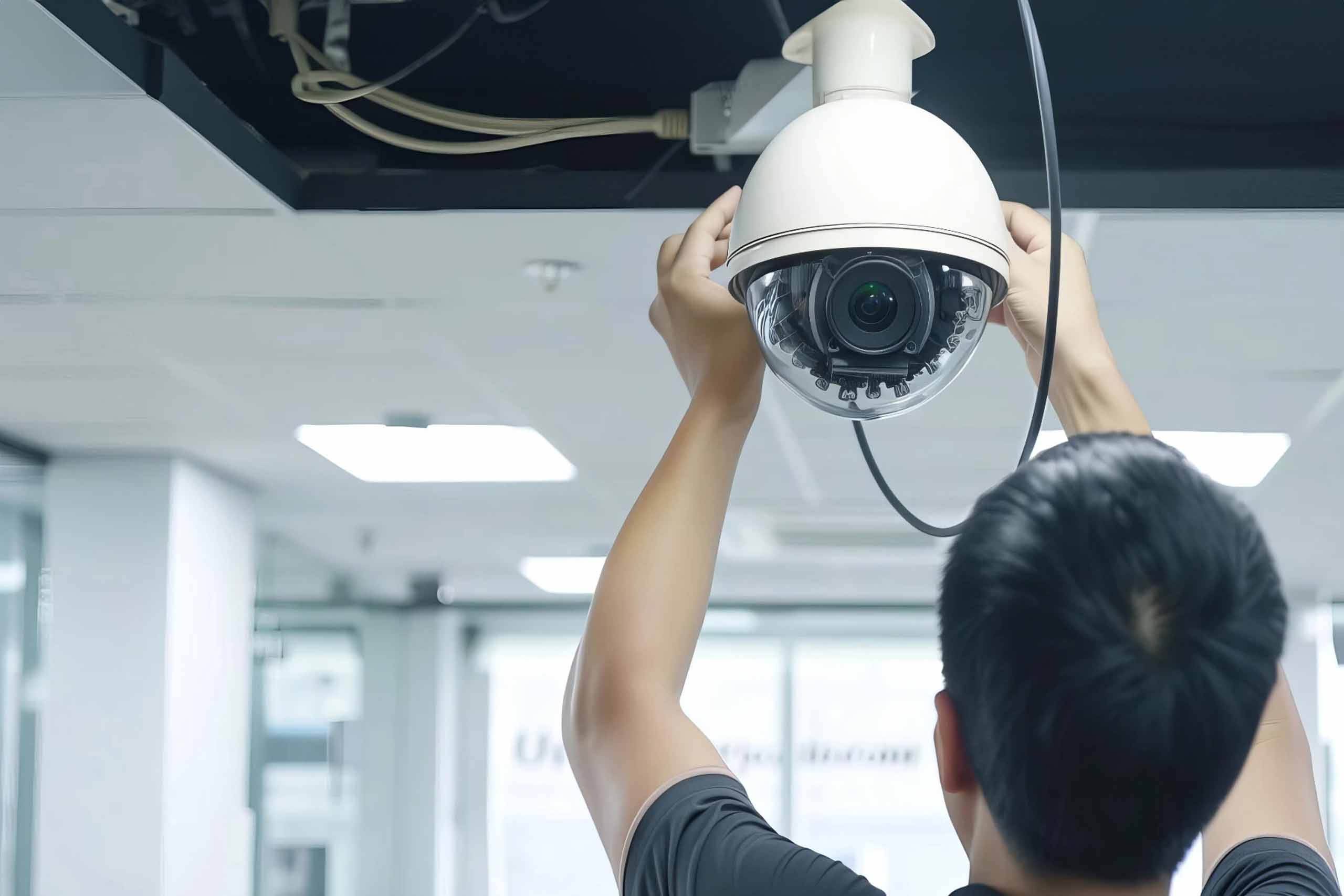It’s an exciting time to work in physical security: Physical security systems are getting more powerful, more capable, and more critical to a business’s mission. Yet as more physical security solutions (including security cameras, access control systems, and sensors) are operating in the cloud and leveraging AI in meaningful ways, physical security leaders are grappling with a corresponding increase in operational complexity.
In the face of this increasing complexity and ever-rising stakes, security leaders are grappling with aging hardware, dated (and usually inaccurate) documentation, constant hardware and software updates, and an unclear roadmap for upgrading technology.
This landscape presents both a challenge and an exciting opportunity for physical security system integrators. Put simply: physical security leaders need help. If you’re a system integrator, you want to put yourself in the position to become that trusted guide that can help businesses future-proof their physical security systems. Our five-step guide shows you how to streamline your site survey and system design processes so you can provide meaningful long-term value to customers.

1. Document Every Device
The first step toward future-proofing is understanding what you (or your customers) already have. This is the foundation of device lifecycle management: it’s just not possible to plan a physical security system upgrade cycle effectively without a comprehensive, accurate, and current list of all devices and components in a physical security system.
So, what needs to go into your documentation? Include at least these elements:
- Security cameras (and other components of video surveillance systems)
- Access control hardware
- Alarms
- Intrusion detection
- Intercoms
- Smart locks
- Sensors (smoke, gunshot detection, etc.)
Of course, simply knowing that a device exists isn’t enough information on its own. You’ll also need to collect data and metadata associated with each device, including:
- Model numbers
- Installation dates
- Firmware versions
- Warranty information
- Exact information
- Planned upgrade cycle
This kind of documentation may seem painstaking, but it’s worth the effort: doing so will prevent orphan devices, speed up troubleshooting, and put businesses in a position to upgrade the right elements at the right time.
Pro Tip: Digital System Design Makes This Easier
We aren’t going to sugar-coat it: comprehensive documentation takes a lot of work! But that work is less difficult and far less time-consuming when done digitally.
A collaborative system design platform that can track specific devices (along with all the right metadata) is far easier to create, use, and update than legacy methods like spiral binders and spreadsheets. Plus, by maintaining documentation in a digital system design, you’ll have an ongoing digital as-built that can be maintained over the life of the system.
University of Wisconsin: “A door isn’t just a door”
The University of Wisconsin faced this challenge across a sprawling 936-acre campus and turned to System Surveyor to do this documentation. Security systems specialist Patrick Bucci explains:
“After all, a door isn’t just a door, it has any number of different hardware that transform that door into a secure access point.”
By using System Surveyor (and its Element Profiles), the university could quickly document and maintain a visual digital as-built, keeping upgrades on track and stakeholders on board. Read the full case study.
Boost to Cybersecurity Too
Documenting devices also boosts digital security: one global study found that 74% of surveyed businesses went through a “cybersecurity incident” of some sort because of unknown or unmanaged assets. That ancient PC powering an outdated surveillance system? It could be the access point that allows cyber threats into your client’s business. The first step toward keeping that system up to date is knowing that it’s there (and that it needs updating).
2. Standardize Across Sites
Every location is unique. But the way you document those locations shouldn’t be.
When each site, facility, or system integrator has unique ways of documenting the work, SIs and organizations can’t easily compare those sites or documents. This adds confusion and inefficiency in all sorts of areas:
- Vendors are confused during maintenance or upgrades
- Businesses lack clarity on which elements need upgrading or maintaining
- Organizations can’t compare sites in concrete terms
Standardizing documentation formats across sites helps larger multi-site organizations such as corporate campuses or healthcare systems eliminate chaos and manage across locations more efficiently.
Here again, digital security system design tools can help because they enable everyone to use the same toolset to do their documentation (rather than some using spreadsheets, others using paper floor plans, and others working from vendor reports). Giving everyone the same canvas and the same set of brushes makes it much easier to enforce consistent processes and standardized security system design.
Not only does standardizing processes help simplify physical security implementation and maintenance, it also helps integrators improve their sales conversions. We’ve found that standardization delivers a 20% increase in sales win conversions on average — while also providing a 35% time and efficiency savings. More sales in less time sounds like a winning formula! Read the full report
Another aspect: elements, even configurations of elements, aren’t. While every site is unique, many door deployments or access control points are similar if not identical. System Surveyor’s Element Profiles tool makes it easy to drag and drop elements and groups of elements, saving time during system design without sacrificing accuracy.
3. Manage the Lifecycle
Physical security devices and equipment don’t last forever. They have a predictable lifecycle that runs through four stages: Installation → Maintenance → Nearing end-of-life → Replacement.
Of course, equipment failure is a real thing, and you’ll never avoid every last “surprise.” But most elements are only surprising to those who don’t manage the lifecycle.
Security hardware has a predictable lifecycle, though this looks different for various device types. Average lifecycles, according to security manufacturers:
- Access control hardware lasts 7-10 years
- Video surveillance cameras last 5-8 years (less in harsh environments)
- Fire alarm systems last 10-15 years
There are two options here: proactive physical security lifecycle management or reactive emergency fixes.
Let’s go with the negative first.
Reactive Approach
Ignoring or failing to manage the lifecycle leads to reactive repairs, rushed procurement, system downtime, higher costs, and system vulnerability.
It’s the classic break/fix mentality, but with a system that organizations can’t afford to leave broken — and sticking with hardware that even the manufacturers admit is past its useful life.
What’s worse, organizations that ignore the realities of the hardware lifecycle often stick with hardware long after support ends. The manufacturer is no longer issuing security updates or has gone out of business entirely, leading to increasingly vulnerable tech. Insecure, un-updated technology compounds security risks and can also cause compliance failure.
Proactive Approach
Proactive organizations plan their system upgrades based on expected lifecycles. Operating this way reduces downtime and emergency repairs, minimizes risk, and enables predictable budgeting.
While it requires more upfront planning and intentional budgeting, the proactive approach is more affordable, safer, and more professional in the long run. It also enables system integrators to position themselves as long-term value-adds, not one-time vendors.
4. Plan for Emerging Technologies
Technology in physical security is changing fast. AI-powered video analytics are getting better at object and anomaly detection, while smart IoT sensors improve building efficiency. Integrators and their customers need to adapt the right way, avoiding ditches on either side.
The “luddite” ditch ignores all emerging technologies, sticking with what’s tried and true. This approach feels like a safe one, but it has an expiration date. Eventually, some emerging tech will just be tech. Ubiquitous, every day, and expected — and this group will be far behind.
The “rushed future” ditch embraces emerging tech, but without proper planning. This approach rushes out and implements the latest tech without making sure those innovations work well together and with the existing system. The other danger here is overspending or duplicating assets. If you don’t know what you have before you start innovating, you may end up spending too much on something that’s unnecessarily complicated.
The center path relies on careful planning and accurate documentation. A well-documented system makes it easy to identify gaps and identify strategic spots to pilot new technologies. A visual system design platform can help here as well, showing on a digital floor plan exactly how and where the new tech integrates into existing infrastructure.
5. Collaborate with Stakeholders
Today’s physical security is no longer siloed. Long gone are the days of a disconnected security camera system recording to physical tape; today, security touches IT, compliance, and facilities. Even business executives are getting involved in a way that was uncommon a decade ago.
System integrators can better future-proof systems by collaborating with all these stakeholders and meeting them with what they care about:
- Integrators need precise installation records.
- IT teams care about networks and cybersecurity.
- Compliance officers need audit trails.
- Executives care about ROI and budgets.
Shared, cloud-based documentation systems allow you to share the right information with everyone who needs it and even allow those stakeholders to collaborate on the design itself. Using a visual, collaborative system design platform like System Surveyor unlocks even more, enabling you to leverage professional illustrations and easy-to-understand visual system designs instead of technical jargon. System Surveyor also helps create a single source of truth accessible to all parties, one that continues to provide value through the entire lifecycle.
Turning Documentation into Strategy
It’s tempting to think of documentation as busy work, something that gets in the way of getting out and making more sales. But as physical security continues growing more complex, documentation is becoming more strategic than ever — especially when you document using the right digital tool.
Follow the 5 steps above to prevent downtime, enable scalability, simplify compliance, and straighten out your future upgrade roadmap. Then supercharge all of it with System Surveyor, the future-ready digital platform for collaborative security system design.
